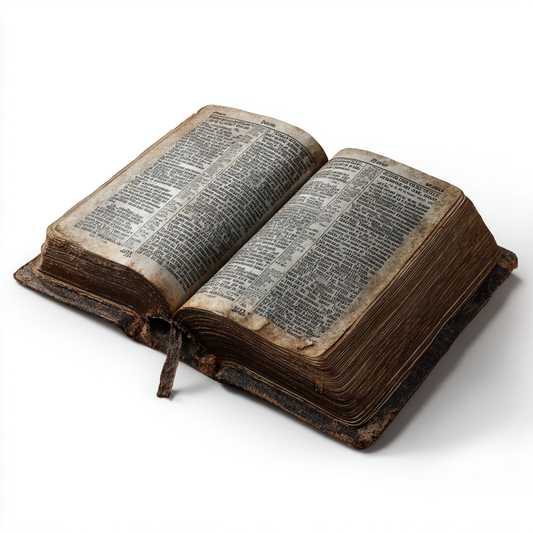What Is the Old Testament? Books, Overview, and Its Connection to the New Testament
Share
Introduction
The Bible is divided into two main sections: the Old Testament and the New Testament. The Old Testament, made up of 39 books, forms the historical, moral, and theological foundation of Scripture. While it was written before the time of Christ, it constantly points toward Him. In this post, we’ll give an overview of what the Old Testament is, list all 39 books with brief summaries, and explain how the Old and New Testaments are deeply connected.
How Many Books Are in the Old Testament?
The Old Testament contains 39 books. These are typically grouped into four major sections: the Law, the Historical Books, the Wisdom Books, and the Prophets.
📘 The 39 Books of the Old Testament (with one-sentence summaries)
(Click book for more in depth summary)
- Genesis – Describes the creation of the world, humanity, sin, and God’s covenant with Abraham.
- Exodus – Tells how God delivered Israel from Egypt and gave them the Law.
- Leviticus – Provides laws for worship, sacrifice, and holiness for Israel.
- Numbers – Chronicles Israel’s wandering in the wilderness and God’s ongoing guidance.
- Deuteronomy – Moses’ final sermons and summary of the Law before Israel enters the Promised Land.
- Joshua – Describes the conquest and division of the Promised Land under Joshua’s leadership.
- Judges – Shows Israel’s cycle of rebellion, oppression, and deliverance by appointed judges.
- Ruth – A story of loyalty and redemption through the lineage leading to David.
- 1 Samuel – Follows Israel’s transition from judges to kings, focusing on Saul and young David.
- 2 Samuel – Chronicles King David’s reign and both his triumphs and failures.
- 1 Kings – Begins with Solomon and recounts the kingdom's split and decline.
- 2 Kings – Continues Israel and Judah’s decline, ending in exile due to disobedience.
- 1 Chronicles – Focuses on David’s reign and the temple’s importance in Israel’s worship.
- 2 Chronicles – Summarizes Judah’s kings and temple-centered faith, ending in exile.
- Ezra – Records the return from exile and rebuilding of the temple in Jerusalem.
- Nehemiah – Tells of rebuilding Jerusalem’s walls and renewing Israel’s faith.
- Esther – A story of God’s providence as Queen Esther saves her people from destruction.
- Job – Explores human suffering, faith, and God’s sovereignty through the trials of Job.
- Psalms – A collection of worship songs, prayers, and reflections on God’s greatness.
- Proverbs – Offers wisdom for living a life that honors God.
- Ecclesiastes – Reflects on the emptiness of life without God and the search for purpose.
- Song of Solomon – A poetic celebration of love and commitment between husband and wife.
- Isaiah – Contains powerful prophecies of judgment and the coming Messiah.
- Jeremiah – A call to repentance before exile, filled with warnings and hope.
- Lamentations – Poetic grief over Jerusalem’s fall and God’s justice and mercy.
- Ezekiel – Visions and messages of judgment, restoration, and God’s glory.
- Daniel – Stories of faith in exile and prophetic visions of future kingdoms.
- Hosea – Uses marriage as a metaphor for God’s faithful love toward unfaithful Israel.
- Joel – Warns of God’s judgment and calls for national repentance.
- Amos – A call for justice and condemnation of empty religion.
- Obadiah – A short prophecy of judgment against Edom for its pride and violence.
- Jonah – Tells of God’s mercy toward Nineveh and Jonah’s resistance to it.
- Micah – Warns of judgment and prophesies the birth of the Messiah in Bethlehem.
- Nahum – Prophesies Nineveh’s final destruction as judgment for sin.
- Habakkuk – A dialogue with God about injustice and trust in His plan.
- Zephaniah – Proclaims God’s coming judgment and future restoration.
- Haggai – Urges the people to rebuild God’s temple after returning from exile.
- Zechariah – Offers apocalyptic visions and encouragement for Israel’s future.
- Malachi – Challenges spiritual complacency and prophesies the coming of John the Baptist.
The Old Testament’s Role in the Bible
The Old Testament is more than a historical or religious text—it is the foundation of the entire biblical narrative. It reveals God's nature, His covenant with Israel, the consequences of sin, and the promise of redemption. The themes of sacrifice, covenant, prophecy, and justice all anticipate a coming Savior—Jesus Christ.
Jesus did not ignore the Old Testament; He fulfilled it. In fact, He said:
“These are the very Scriptures that testify about me.” —John 5:39 (NIV)
How the Old Testament Connects to the New Testament
The Old and New Testaments are not separate stories, but two parts of one unified revelation. The New Testament does not start a new religion—it completes what the Old Testament began. Many prophecies, images, and rituals in the Old Testament point forward to Jesus and are fulfilled in the New.
Examples of Cross-References:
- Isaiah 53 – Prophesies the suffering servant, fulfilled in Jesus’ crucifixion (see Matthew 8:17, 1 Peter 2:24).
- Psalm 22 – Describes details of Jesus’ crucifixion centuries before it happened (see Matthew 27).
- Genesis 3:15 – The first mention of a coming Savior after the fall, referenced throughout the New Testament.
- Exodus and Hebrews – The Passover lamb and tabernacle system foreshadow Christ as the final sacrifice (Hebrews 10).
The writers of the New Testament quoted the Old Testament hundreds of times. Understanding the Old Testament enhances your grasp of the gospel and the mission of Jesus.
Final Thoughts
The Old Testament contains 39 inspired books that form the beginning of God’s great story. Though written long before Christ, every chapter prepares the way for Him. It reveals God’s plan, His promises, and His faithfulness through generations. When you read the New Testament, you are reading the fulfillment of everything the Old foretold.
Two testaments—one unified message: redemption through Jesus Christ.





